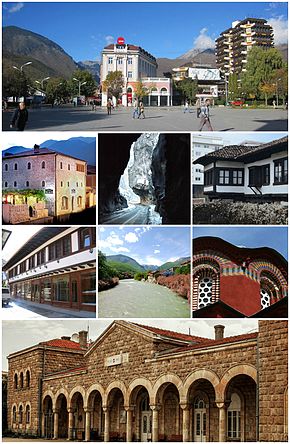
Back بيخا Arabic بيخا (مدينه فى پيك مونيسيپاليتى) ARZ Peç (Kosovo) Azerbaijani Печ (Косово) Bulgarian Peć BS Pejë Catalan Pec District CEB Peć Czech Peja German Ιπέκιο Greek
This article needs to be updated. (May 2022) |
Peja | |
|---|---|
City and municipality | |
 View of Peja | |
| Coordinates: 42°39′37″N 20°17′30″E / 42.66028°N 20.29167°E | |
| Country | Kosovo |
| District | Peja |
| Municipality | Peja |
| Government | |
| • Type | Mayor–council |
| • Mayor | Gazmend Muhaxheri (LDK) |
| • Council | Peja Municipal Council |
| Area | |
| • Municipality | 602.63 km2 (232.68 sq mi) |
| • Rank | 3rd in Kosovo |
| Elevation | 516 m (1,693 ft) |
| Population (2011[2]) | |
| • Municipality | 96,450 |
| • Rank | 4th in Kosovo |
| • Density | 160/km2 (410/sq mi) |
| • Urban | 70,000 |
| • Rural | 47,488 |
| • Ethnicity | |
| Demonym(s) | Albanian: Pejan (m), Pejane (f) |
| Time zone | UTC+1 (CET) |
| • Summer (DST) | UTC+2 (CEST) |
| Postal code | 30000 |
| Area code | +383 (0) 39 |
| Vehicle registration | 03 |
| Website | kk.rks-gov.net/peje/ |
Peja[a] is the fourth most populous city in Kosovo and serves as the seat of the Peja Municipality and the District of Peja. It is located in the Rugova region on the eastern section of the Accursed Mountains along the Lumbardhi i Pejës River in the western part of Kosovo.
In medieval times the city was under Byzantine and Bulgarian rule. When it was captured by Serbians, it became the seat of the Serbian Orthodox Church in 1346. The Patriarchal monastery of Peć is a UNESCO World Heritage Site as part of the Medieval Monuments in Kosovo. Under Ottoman rule the city, then commonly known under the Turkish name İpek, became a district capital with mosques and civil architecture. From the end of the nineteenth century until today, the city has been the site of nationalist aspirations and claims for both ethnic Albanians and Serbs, often resulting in tense inter-ethnic relations and conflict.
According to the 2011 census, the city of Peja has 48,962 inhabitants, while the municipality has 96,450 inhabitants. The municipality covers an area of 602 km2 (232 sq mi), including the city of Peja and 95 villages; it is divided into 28 territorial communities.
- ^ "Komisioni për majten e territorit të Republikës së Kosovës" (PDF) (in Albanian). Prime Minister Office of Kosovo. p. 52. Archived from the original (PDF) on 22 September 2020. Retrieved 3 October 2021.
- ^ "Regjistrimi i Popullsisë, Ekonomive Familjare dhe Banesave në Kosovë 2011 – Rezultatet Përfundimtare: Të Dhënat Demografike sipas Komunave" (PDF) (in Albanian). Kosovo Agency of Statistics. p. 14. Archived from the original (PDF) on 4 March 2016. Retrieved 3 October 2021.
Cite error: There are <ref group=lower-alpha> tags or {{efn}} templates on this page, but the references will not show without a {{reflist|group=lower-alpha}} template or {{notelist}} template (see the help page).



